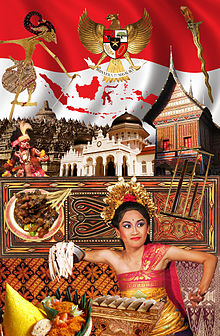This article needs additional citations for verification. (May 2024) |

| Part of a series on the |
| Culture of Indonesia |
|---|
 |
| People |
| Languages |
| Mythology and folklore |
| Cuisine |
| Literature |
| Music and performing arts |
| Sport |
Javanese dance (Indonesian: Tarian Jawa; Javanese: ꧋ꦠꦫꦶꦗꦮ, romanized: Beksan Jawa) is the dances and art forms that were created and influenced by Javanese culture in Indonesia. Javanese dance movement is controlled, deliberate, and refined. Javanese art often displays finesse, and, at the same time, a serene composure which is elevated far above everything mundane.[1] Javanese dance is usually associated with courtly, refined, and sophisticated culture of the Javanese kratons, such as the bedhaya and srimpi dance. However, in a wider sense, Javanese dance also includes the dances of Javanese commoners and villagers, such as ronggeng, tayub, reog, and jaran kepang.
Javanese dance and its discipline has different styles and philosophy compared to other Indonesian dance traditions. Unlike vigorous and expressive Balinese dance or cheerful and slightly sensual Sundanese dance, Javanese dance are commonly involving slow movements and graceful poses. Javanese dance have somewhat a meditative quality and tends to be more self-reflective, introspective and more oriented toward self-understanding.[2] Javanese dance is usually associated with Wayang wong, and the palaces of Yogyakarta and Surakarta due to the nature of dance being a pusaka or sacred heirloom from ancestors of the palace rulers. These expressive dances are more than just dances, they are also used for moral education, emotional expression, and spreading of the Javanese culture.
- ^ Lieberman, Fredric. "Relationships of Musical and Cultural Contrasts in Java and Bali". University of California Santa Cruz. Archived from the original on July 8, 2015. Retrieved March 9, 2013.
- ^ Kuncoro (23 August 2010). ""Harjuna Wijaya" Bedhaya Dance, Level of Human Perfection". Indonesia Culture.net. Archived from the original on 13 September 2010. Retrieved March 9, 2013.